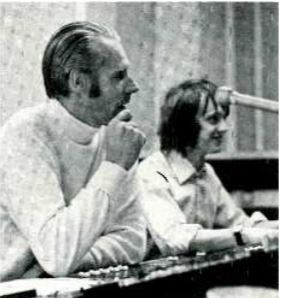
WW: Beatles records, especially since Sgt. Pepper, have caused a rekindling of interest in the electric bass. Was bass a particular problem in recording the Beatles?
GM: Paul was always worrying me to get more bass on the records, certainly, and it was my job to try and get that bass on, true. Probably it was the single most worrying factor, of any sound that we produced, because Paul is a perfectionist and even when we got a great bass sound he didn’t think it was very good. Now, you say that we got some great bass sounds, which is nice to know. I’d like you to relay that information to Paul.
WW: I’d be glad to.
WW: Could you describe a technique you used on the bass on Abbey Road, say, for example, “Come Together”?
GM: I think on that particular one we used a combination of direct injection and live sound.
WW: And limiting/compression?
GM: Yes, of course, and also a little bit of echo too. But each sound is treated on its own merits. That’s why we, in fact, got lots of varied sounds, some of which were not so good as others.
WW: The instruments and voices on Abbey Road have a particular clarity and presence that seem to be derived from close-miking or similar techniques. Was directed it in the studio. Everything else was mine. this your aim?
GM: I was aiming for clarity, but oddly enough, it isn’t very necessarily close-mike techniques that provide this. This essence of that clarity that you talk about is the ability to differentiate one sound that is interfering with your bass, for example, then you do something about it. You change it. And I think the clarity comes from having distinguishable sounds anyway.
WW: Then from a production standpoint, if you’re going to have two sounds in the same frequency range, they should be playing approximately the same part, or else they will muddle each other?
GM: That’s right.
WW: Did you do all the horn and string arrangements for the Beatles?
WW: Yes, with one exception. Oh, I certainly didn’t do the “Let It Be” one, which Phil Specter did. I was quick to disown that. There was one exception; it was one of the string ones, which an English arrange did. He gave us the score because I wasn’t around at the time and Paul wanted it done very quickly. Mike Leander it was on one title. He gave us the score and I directed it in the studio. Everything else was mine.
WW: Do you think that you’ll work with the Beatles again, or any of he Beatles?
GM: In the answer to the first question, I think it’s possible if the Beatles ever work together again. As to the individual Beatles, I don’t know. Each one of them is very talented, two of them in particular, in fact George, John, and Paul are obviously more talented than Ringo.
All four of them are very talented anyway, but none of them is as strong as the four of them together. The four individual parts were not as great as the entire whole. The Beatles, four people together, did something that nobody else had ever done before, and the fact that they’re not together I think is a very sad thing.
Editor’s Note: This is a series of articles from Recording Engineer/Producer (RE/P) magazine, which began publishing in 1970 under the direction of Publisher/Editor Martin Gallay. After a great run, RE/P ceased publishing in the early 1990s, yet its content is still much revered in the professional audio community. RE/P also published the first issues of Live Sound International magazine as a quarterly supplement, beginning in the late 1980s, and LSI has grown to a monthly publication that continues to thrive to this day.
Our sincere thanks to Mark Gander of JBL Professional for his considerable support on this archive project.
